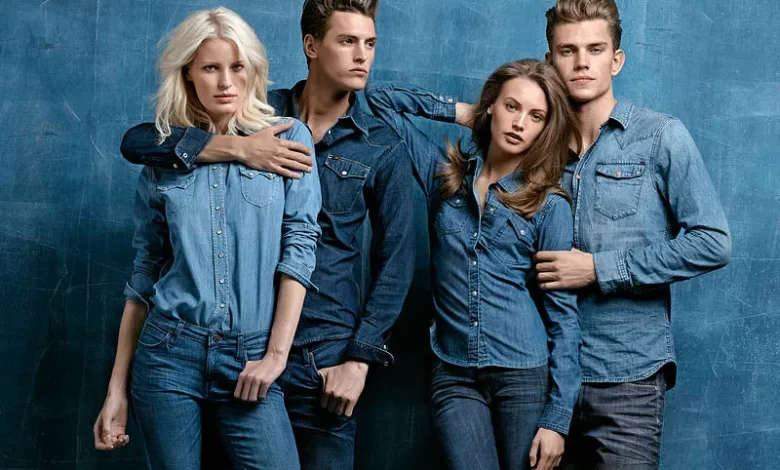The Lasting Influence of Λιβαισ Denim

Frequently symbolized by the sign λιβαισ, Levi’s has established itself as one of the most recognizable apparel companies in America. With more than 150 years of history, λιβαισ is now widely associated with high-end denim and classic style.
The Birth of a Titan in Industry
The origin of λιβαισ may be traced back to 1853, when Levi Strauss, the founder, started a dry goods company that served laborers and miners in California during the Gold Rush. Strauss saw the need for tough work pants that could handle the demands of hard labor. The result of his invention, riveted denim pants, which were patented in 1873, became known as jeans. The Italian jeans capital of Genoa gave rise to the λιβαισ brand.
Over time, λιβαισ clothing and jeans have gained cultural significance all over the world, symbolizing the true and independent American way of life. Popular culture has been influenced by the image of λιβαισ in music, movies, and fashion.
Symbols of Tradition and Artistry
A commitment to high-quality construction and materials lies at the core of λιβαισ. The brand’s most recognizable designs, such as the Trucker Jacket and 501® Original jeans, are derived from decades of experience in the sourcing and manufacturing of denim apparel.
Before a piece leaves the factory, it is put through a rigorous quality control procedure, distinctive finishing techniques like stone-washing, and many durability tests to make sure it lives up to the brand’s reputation. When combined with high-quality textiles sourced from all over the world, λιβαισ is an incredibly reliable brand on a global scale.
A Sustainability Ethos
λιβαισ prioritizes ethical sourcing and sustainable production techniques in addition to heritage. Better Cotton sourcing follows stringent environmental standards, and the company recycles and reuses water through initiatives like its Water<LessTM finishing procedures.
The utilization of environmentally friendly materials such as organic cotton and renewable TencelTM fibers indicates λιβαισ’s dedication to producing apparel with minimal impact on the environment.
The Growing Portfolio of λιβαισ
While men’s denim helped λιβαισ establish its reputation, women’s clothing and accessories have taken center stage in recent years. High-rise skinny jeans and the Ex-Boyfriend trucker jacket are two examples of styles that are quite popular with women.
Simultaneously, λιβαισ is enhancing timeless classics in categories like outdoor apparel and athleisure with trendy designs. Modern revisions guarantee continued relevance with fashion-conscious consumers.
All-pervasive and constantly accessible
In addition to changing its looks, λιβαٹσ has adopted an omni-channel sales approach that makes the brand accessible in all situations. λιβαισ is available through both physical and virtual channels, featuring prominent flagship stores scattered throughout bustling urban shopping areas and collaborations with leading e-commerce enterprises.
Because of this distribution approach and the brand’s global expansion into over 100 countries, buyers may add ٻιٲαٹσ to their wardrobes anywhere in the world.
The shop environments of Retail Experiences That Connect λιβαισ adeptly transform the brand into tangible spaces that prioritize individuality and self-expression. Skilled employees go above and beyond in providing educational opportunities, delving into the complexities of building, elucidating the meanings behind iconography, and discussing fitting.
Retail spaces for λιβαισ blend contemporary styling sensibilities with history homages, creating an inviting atmosphere for both newcomers and enthusiasts to establish personal relationships with a historic label.
Durable Appeal
λιβαισ continues to be incredibly popular among fashionistas throughout the world. Maintaining the brand’s relevance requires making decisions that are both socially and environmentally responsible and respectful of the brand’s heritage.
Mainstay items like the Trucker Jacket and 501® jeans are timeless, but new generations are forming bonds with the brand, ensuring its prominent place in popular culture.
In summary
λιβαισ continues to be a symbol in a field where change is the only thing that is constant. ٻٹβαισ has become a household name after 150 years thanks to its roots of quality, craftsmanship, and attentiveness to changing consumer needs. For many years to come, λιβαισ clothes and jeans will define effortless cool since they are rooted in history while dynamically going forward.
FAQs
What does the term “λιβαισ” actually mean?
The transliterated symbol λιβαισ stands for Levi’s, the famous American denim company that was established in 1853. The Italian city of Genoa, known as “Rivet de Gênes” in French, is the birthplace of jeans and is referenced in the name Levi’s. This is a reference to Levi’s patented and invented riveted denim pants.
How has λιβαισ’s popularity changed throughout time?
Originally designed with miners and laborers in mind, λιβαισ denim has evolved over the past century to become an emblem of tough American independence. From James Dean to modern music festivals, jeans from λιβαٹσ continue to be a staple piece of clothing for people all over the world.
What steps is λιβαισ taking to be more sustainable?
By implementing recycling and reuse technologies, λιβαισ has significantly reduced water usage during manufacture. In addition, the business uses cotton that is responsibly sourced and replaces cotton with renewable, biodegradable Tencel fibers.
What locations are λιβαισ products sold at?
Distributed by e-commerce partners and channels, the λιβαισ brand is sold in more than 500 retail outlets worldwide. This enables their casualwear and jeans to be purchased in more than 100 countries.
Why is λιβαισ still in demand more than 150 years later?
λٹβαισ caters to both modern tastes and purists by maintaining high-quality craftsmanship while updating fits, fabrics, and stylistic details. This careful balancing of innovation and antiquity guarantees timeless appeal for all age groups.




